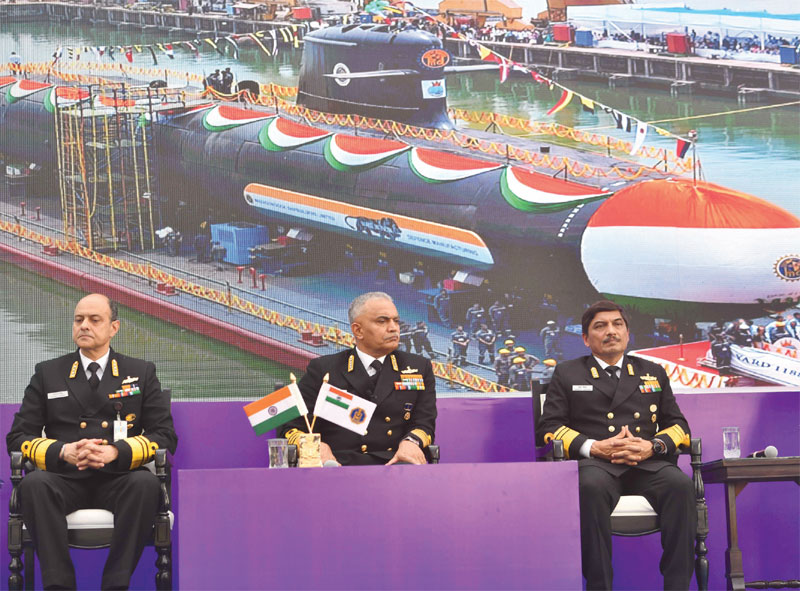Growing maritime interest calls for a better network of support fleet, helicopters and submarines
Mohammad Asif Khan
The Indian Navy is playing an important role in the Indo-Pacific region ‘for a free, open and rules-based Pacific region’ through constant presence, responses to situations and cooperation with friendly countries, Chief of Naval Staff Admiral R Hari Kumar said in a talk on the ‘Indo-Pacific Challenges and Way Ahead’.

Speaking at the conclave held by the Synergia Foundation, the CNS said, “If the Indian Navy has to secure the country’s interests in the Indo-Pacific, safe and secure seas become an imperative”.
The Indian Navy’s significance has heightened due to the increasing importance of the Indian Ocean Region (IOR) in the geopolitical landscape, characterised by India’s closer ties with the US and China’s expanding influence in the Asia-Pacific and the South China Sea.
Highlighting specific concerns, Admiral Hari Kumar pointed to China, saying that the country, “…for instance, is pushing the envelope with unilateral actions, encroachments in the South China Sea or with alter or expansionist designs in the Indian Ocean with the acquisition of ports and bases”.
In an interview with FORCE in January the Navy chief had said, “The Indian Navy today stands as a balanced, modern, and multi-dimensional force equipped for diverse operations in the Indian Ocean Region and beyond. With over 130 ships, submarines, and 240 aircraft, we’re addressing current shortfalls through the induction of 43 ships and two submarines in the near term.”
India’s extensive coastline is strategically situated at the nexus of the Indian Ocean, the Pacific Ocean and the Arabian Sea. This geographical positioning underscores India’s critical stake in maritime security. However, of late, India’s maritime security interests have been shaped by its relationships with the US and China. India is a member of the QUAD, which is seen as a counterbalance to China’s growing influence in the region. India has also been participating in several multilateral maritime security initiatives, such as the Indian Ocean Cooperation Initiative (IORI) and the ReCAAP (Regional Cooperation Agreement on Combating Piracy and Armed Robbery against Ships in Asia) Information Sharing Centre (ISC).
To effectively meet its objectives in the IOR and beyond, the Indian Navy requires a network of robust and versatile support fleet, submarines and helicopters that can support its maritime operations.
The nation’s maritime concerns encompass safeguarding its sea lanes of communication (SLOCs), pivotal for its trade-centric economy. Given that a significant portion of India’s trade transpires through sea routes, ensuring the security of these passages against piracy, terrorism and assorted threats becomes imperative.
India’s expansive exclusive economic zone (EEZ) teems with valuable natural resources such as oil, gas and fisheries. Protecting these resources from unauthorised exploitation is a crucial aspect of its maritime interests.
Within the IOR, the Indian Navy serves as the primary guarantor of maritime security, deterring and combating threats such as piracy, terrorism and illegal activities at sea. The Indian Navy also plays a leading role in humanitarian assistance and disaster relief (HADR) operations within the IOR, extending assistance to countries affected by natural disasters or humanitarian crises.
In carrying out these operations the Indian Navy requires a vast inventory of platforms, including support fleet, helicopters and submarines which form the backbone of the navy in peace and in times of war.
Support Fleet
India’s support fleet is essential for providing logistical support to its warships and submarines. This includes providing fuel, ammunition, food and medical supplies. India needs to expand its support fleet to ensure that its warships and submarines can operate for extended periods away from home.
“The supply ships are the lifeline for our fleets, providing vital resources essential for naval operations. They act as the backbone, supplying medical aid, food, engineering equipment and crucial fuels to other ships. Without these support vessels, our naval operations would face severe limitations,” says Vice Admiral Shekhar Sinha.
Support fleets, particularly tankers or supply ships, are integral for refuelling naval vessels at sea. These vessels ensure the continuous operation of warships by providing essential supplies such as fuel, water and other fluids crucial for their functioning.
By maintaining a steady supply of fuel and fluids, these support ships enable naval fleets to undertake extended deployments without needing to return to port frequently for refuelling. This capability significantly extends the range and operational endurance of warships, allowing them to remain at sea for extended periods, which is vital for both peacetime operations and during critical missions or conflicts.
In 2023, the ministry of defence signed a contract with Hindustan Shipyard Limited (HSL) to acquire five Fleet Support Ships (FSS) for the Indian Navy at an overall cost of approximately INR 19,000 crore. The induction of these ships will significantly enhance the blue-water capability of the Indian Navy. The ships can also be deployed for evacuation of people, and HADR operations.
The Indian shipyard will construct the first-of-its-kind fleet support ships of 44,000 tonnes in India. HSL will undertake the indigenous design and construction of these ships, slated for commissioning into the Navy by 2032.
Currently, the Indian Navy has 18 support vessels, but according to senior naval personnels, it needs at least 30 to effectively support its growing fleet of warships and submarines. The navy is facing a shortage of support ships due to several factors, including budget constraints, delays in ship construction, and a lack of indigenous shipyards capable of building these complex vessels.
“Budgetary constraints pose a significant challenge for the modernisation of our naval fleet. India, not being as resource rich as some other nations, faces limitations in allocating funds to meet the extensive requirements of naval modernisation. This financial aspect plays a crucial role in shaping the pace and extent of advancements in our naval capabilities,” says Sinha.
You must be logged in to view this content.

